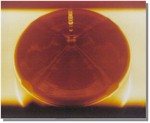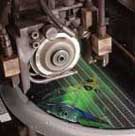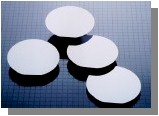Substrate Manufacture
- Polycrustalline Silicon Production
-
To manufacture polycrystalline silicon, ultra-pure silicon is produced from raw quartzite (silica sand) that is melted and reduced to silicon in an electric arc furnace at over 1900ºC. This metallurgical-grade silicon is drawn from the furnace and blown with oxygen or an oxygen-chloride mixture to reduce the levels of impurities to achieve approximately 99% pure silicon. Next, the silicon is reacted with hydrogen chloride gas in the presence of a copper-containing catalyst to form trichlorosilane (SiHCl3). The trichlorosilane is reduced to very pure silicon by reacting it with hydrogen at high temperatures (about 1100ºC). This "electronic grade" silicon has less than 1 ppb of impurities.
The following are the potential hazards of polycrustalline silicon production.
Silica (Crystalline)
Potential Hazard
- Possible employee exposure to crystalline silica used as a raw material. Inhalation of silica can lead to chronic, accelerated or acute silicosis and is associated with bronchitis and tuberculosis. Some studies also indicate an association with lung cancer. Exposures to silicon dust may also occur; controls are similar to those used for crystalline silica.
Possible Solutions
- Identify silica hazards and perform appropriate exposure evaluations.
- Identify and evaluate all potential exposure scenarios, for example: startup, operations, maintenance, cleaning, emergencies, and so forth.
- 29 CFR 1910.1000 Table Z-3 provides permissible exposure limits for crystalline silica.
- OSHA Technical Manual (OTM). OSHA Directive TED 01-00-015 [TED 1-0.15A], (1999, January 20).
- Sampling for Special Analyses Includes sampling information for crystalline silica.
- Provide appropriate ventilation to reduce silica concentration levels in the air.
- Maintain adequate housekeeping to remove unwanted silica dust and reduce concentration levels.
- Use respiratory protection when necessary to further reduce exposure and protect employees. [29 CFR 1910.134]
Additional Information
OSHA Safety and Health Topics Pages:
Hydrogen Chloride Gas
Potential Hazard
- Possible employee exposure to hydrogen chloride gas. Hydrogen chloride is irritating and corrosive to the eyes, skin, and mucous membranes. Exposure to high concentrations can cause laryngitis, bronchitis, and pulmonary edema.
Possible Solutions
- Identify hydrogen chloride hazards and perform appropriate exposure evaluations.
- Identify and evaluate all potential exposure scenarios, for example: startup, operations, maintenance, cleaning, emergencies, and so forth.
- 29 CFR 1910.1000 Table Z-1 provides permissible exposure limits for hydrogen chloride.
- Occupational Health Guidelines for Chemical Hazards. US Department of Health and Human Services (DHHS), National Institute for Occupational Safety and Health (NIOSH) Publication No. 81-123, (1981, January). Provides a table of contents of guidelines for many hazardous chemicals. The files provide technical chemical information, including chemical and physical properties, health effects, exposure limits, and recommendations for medical monitoring, personal protective equipment (PPE), and control procedures.
- Provide appropriate ventilation to reduce hydrogen chloride concentration levels in the air.
- Provide PPE as appropriate to prevent eye and skin contact with hydrogen chloride. [29 CFR 1910 Subpart I]
- Use respiratory protection when necessary to further reduce exposure and protect employees. [29 CFR 1910.134]
Additional Information
OSHA Safety and Health Topics Pages:
- Single Crystal Ingot Growth
-

Almost all crystal growth is done by the Czochralski (Cz) method. This method begins by heating electronic-grade polycrystalline silicon in a quartz crucible to 1200ºC in an argon atmosphere. Either radiofrequency (RF) or resistance heating is used. A starter or "seed" crystal of silicon is placed onto the end of a rod and dipped into the melt to form the crystal. The seed and crucible are rotated in opposite directions while the seed is withdrawn. Silicon atoms attach to the rod and the crystal grows in size. Careful control of temperature, rotation speed, and vertical withdrawal determines the size of the ingot. Different atmospheres (inert, oxidizing, reducing) and pressures (vacuum, high pressure) also are maintained in the growth chamber depending on the type of crystal desired.
Controlled amounts of impurities are added during crystal growth to establish the desired electrical properties for the silicon. The melt is usually "doped" with elements like boron, phosphorous, arsenic, or antimony.
The following are the potential hazards of single crystal ingot growth.
Metals and Salts
Potential Hazard
- Possible employee exposure to various metals and salts used for elemental dopants, including phosphorous, boron, arsenic, antimony, magnesium, etc.
Possible Solutions
- Identify metal hazards and perform appropriate exposure evaluations.
- Perform exposure measurements for the compounds used.
- Keep exposures below acceptable exposure levels.
- Address all dermal exposures.
- Provide appropriate ventilation to reduce concentration levels in air.
- Provide PPE as appropriate to prevent contact. [29 CFR 1910 Subpart I]
- Use respiratory protection when necessary to further reduce exposure and protect employees. [29 CFR 1910.134]
- Maintain adequate housekeeping to remove unwanted metals and reduce concentration levels.
Additional Information
- Preventing Occupational Illnesses through Safer Chemical Management. OSHA.
- Occupational Health Guidelines for Chemical Hazards. US Department of Health and Human Services (DHHS), National Institute for Occupational Safety and Health (NIOSH) Publication No. 81-123, (1981, January). Provides a table of contents of guidelines for many hazardous chemicals. The files provide technical chemical information, including chemical and physical properties, health effects, exposure limits, and recommendations for medical monitoring, personal protective equipment (PPE), and control procedures.
OSHA Safety and Health Topics Pages:
- Ingot Evaluation and Machining
-

Before the ingots are sliced into wafer substrates, the ends of the new single-crystal ingot are cropped using a water-lubricated single-bladed diamond saw. The ingot is then placed on a lathe and ground to a uniform diameter. The ends of the cropped and ground ingots are chamfered (beveled), using a dry belt sander, which reduces the possibility of shattering the ingot. The crystal structure of the ingot is determined by x-ray diffraction, then a longitudinal section of the ingot cylinder is removed by wet grinding to produce a "flat". This flat is used to mark the crystal orientation of the ingot.
The following are the potential hazards of ingot evaluation and machining.
- Wafer Preparation
-

To prepare the wafers, ingots are sliced into individual wafers with multiple-blade inner-diameter saws. This operation is done with wet lubricants, and in some processes the wafers are stored in plastic reservoirs containing water or methanol. The sliced wafers are mechanically lapped under pressure using a counter-rotating machine to achieve flatness and parallelism on both sides of the wafer. Most lapping operations use slurries of either aluminum oxide or silicon carbide. The edges of the individual wafers are also rounded by the use of wet automatic grinders.
After lapping, wafers are etched with a solution containing nitric, acetic, and hydrofluoric acids. Etching may be done in manual etch tanks or by automated etching machines. This etching process removes external surface damage and reduces the thickness of the wafer.

Next, the wafers are polished using an aqueous mixture of colloidal silica and sodium hydroxide. The wafers are mounted onto a metal carrier plate that is attached by vacuum to the polishing machine. The polishing process usually involves two or three polishing steps with progressively finer slurry, which decreases wafer thickness and results in a mirror-like finish. Sometimes carrier pads must be stripped from the metal carrier plates. The pads are usually stripped with solvents such as methylene chloride, methyl ethyl ketone, or a glycol ether mixture.

Finally, the wafers are cleaned to remove any particles or residue remaining on the exterior surface of the polished wafer. Various cleaning steps and solutions containing ammonia, hydrogen peroxide, hydrofluoric acid, hydrochloric acid, and deionized water may be used.
The finished wafers are inspected and packaged for shipping. It should be noted that most semiconductor manufacturers purchase wafers from firms that specialize in wafer production.
The following are the potential hazards of wafer preparation.
Methanol
Potential Hazard
- Possible employee exposure to methanol during wafer washing and storage.
Possible Solutions
- Identify methanol hazards and perform appropriate exposure evaluations.
- Perform exposure measurements.
- Keep exposures below acceptable exposure levels.
- Address all dermal exposures.
- Provide appropriate ventilation to reduce solvent concentration levels in the air.
- Provide PPE as appropriate to prevent eye and skin contact. [29 CFR 1910 Subpart I]
- Use respiratory protection when necessary to further reduce exposure and protect employees. [29 CFR 1910.134]
Additional Information
OSHA Safety and Health Topics Pages:
- Dermal Exposure
- Personal Protective Equipment (PPE)
- Respiratory Protection
- Sampling and Analysis
- Ventilation
Acids
Potential Hazard
- Possible employee exposure to acids used during etching. Typical acids may include HF, CH3COOH, and HNO3.
Possible Solutions
Additional Information
- Preventing Occupational Illnesses through Safer Chemical Management. OSHA.
- Occupational Health Guidelines for Chemical Hazards. US Department of Health and Human Services (DHHS), National Institute for Occupational Safety and Health (NIOSH) Publication No. 81-123, (1981, January). Provides a table of contents of guidelines for many hazardous chemicals. The files provide technical chemical information, including chemical and physical properties, health effects, exposure limits, and recommendations for medical monitoring, personal protective equipment (PPE), and control procedures.
Solvents
Potential Hazard
- Possible employee exposure to solvents used for stripping carrier pads. Typical solvents may include methylene chloride, MEK, and glycol ethers.
Possible Solutions
Additional Information
- Methylene Chloride. OSHA Safety and Health Topics Page.
Chemicals
Potential Hazard
- Possible employee exposure to additional chemicals used for final cleaning. Typical chemicals may include NH3, H2O2, HF, and HCl.
Possible Solutions
Additional Information
- Preventing Occupational Illnesses through Safer Chemical Management. OSHA.
- Occupational Health Guidelines for Chemical Hazards. US Department of Health and Human Services (DHHS), National Institute for Occupational Safety and Health (NIOSH) Publication No. 81-123, (1981, January). Provides a table of contents of guidelines for many hazardous chemicals. The files provide technical chemical information, including chemical and physical properties, health effects, exposure limits, and recommendations for medical monitoring, personal protective equipment (PPE), and control procedures.

